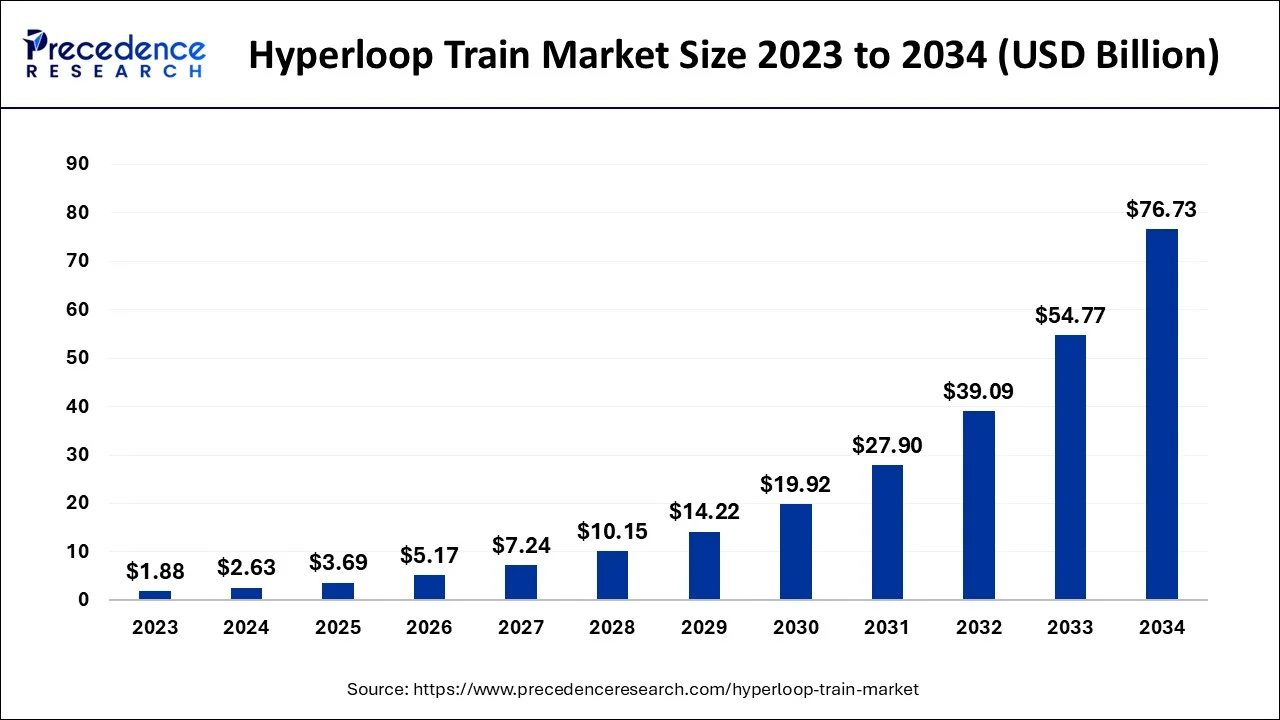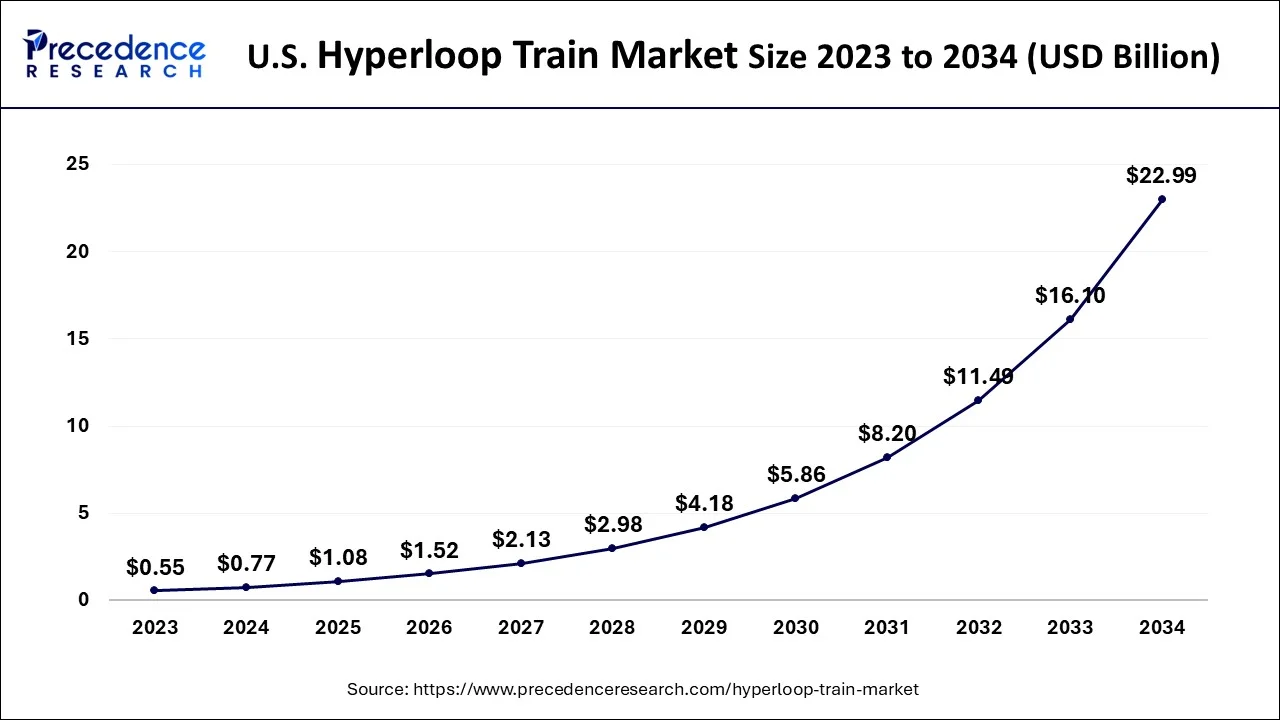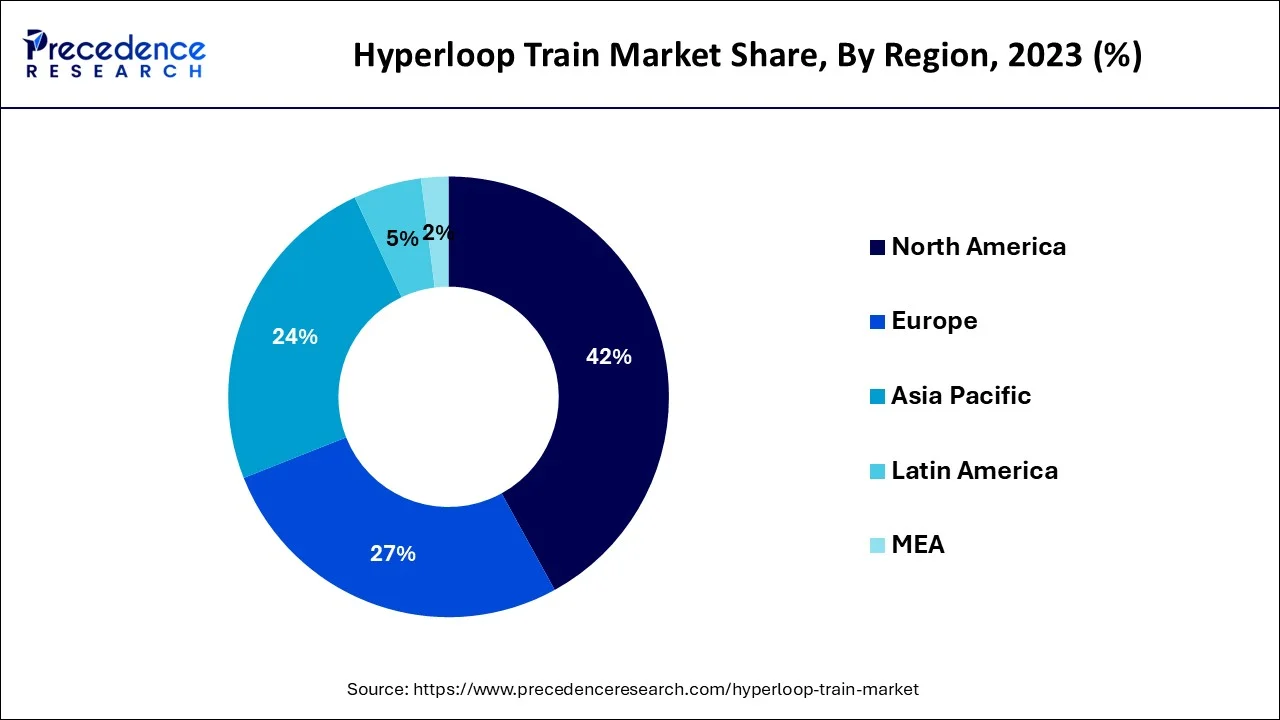April 2025
The global hyperloop train market size accounted for USD 2.63 billion in 2024, grew to USD 3.69 billion in 2025 and is projected to surpass around USD 76.73 billion by 2034, representing a healthy CAGR of 40.10% between 2024 and 2034. The North America hyperloop train market size is calculated at USD 1.10 billion in 2024 and is expected to grow at a fastest CAGR of 40.24% during the forecast year.
The global hyperloop train market size is estimated at USD 2.63 billion in 2024 and is anticipated to reach around USD 76.73 billion by 2034, expanding at a CAGR of 40.10% between 2024 and 2034.

The U.S. hyperloop train market size accounted for USD 0.77 billion in 2024 and is predicted to be worth around USD 22.99 billion by 2034, growing at a CAGR of 40.40% from 2024 to 2034.

Due to the existence of well-known hyperloop technology providers like Hyperloop Technologies, North America has a sizable market share. Virgin's first and second Hyperloops. In the early adoption of the hyperloop train industry, North America emerged as the main area due to increased R&D spending and technical improvement. As a result, North America is delaying its ascent to the top of the market. The major companies in this area are concentrating on a strategy of partnership to increase their capacity for manufacturing. For instance, in June 2019, Virgin Hyperloop One collaborated with Washington University in St. Louis' Sam Fox School of Designs and Visual Arts. The objective is to introduce hyperloop technology to Missouri and to continue investigating several designs for the Missouri hyperloop train.

The world's fastest-growing region is Asia Pacific. The government agencies' increasing interest in determining if hyperloop technology trains are feasible is expected to boost market expansion. For instance, in July 2019, Virgin Hyperloop One and the Maharashtra government signed a memorandum of understanding to build a hyperloop rail system connecting Mumbai and Pune in India. The objective is to provide end users with the fastest and most affordable form of transportation possible. As a result, the Asia Pacific region is anticipated to become a significant market contributor in the future.
The term "hyperloop train" describes the fastest intercity surface transportation system that makes use of pod- or capsule-shaped vehicles that operate in a sealed tube with low pressure. The Hyperloop train technology is expected to move at an average speed of 600–760 mph, which is quicker than existing forms of transportation like water, air, rail, and road.
On the strength of a rise in the need for speedier transportation options throughout the world, the worldwide market for Hyperloop trains is anticipated to grow at a promising rate in the forecast future. The Hyperloop train technology is also gaining popularity because of all the benefits it offers over other forms of transportation, including cost-effectiveness, energy efficiency, and environmental friendliness. These benefits have led to a significant increase in investments in Hyperloop train technology, which is supporting the growth of the worldwide Hyperloop train market. The increased need for traffic decongestion throughout the world is anticipated to benefit the worldwide market for hyperloop trains. Players in the worldwide Hyperloop train market are working harder to discover answers to several technical problems that would arise throughout the use of this technology. Additionally, a number of businesses in the market for Hyperloop trains are concentrating on finding solutions to the issues brought on by a lack of electricity. In addition, it is anticipated that an increase in R&D initiatives by several top firms would fuel the growth of the worldwide Hyperloop train market in the years to come.
In the coming years, the worldwide market for hyperloop trains is projected to experience rapid growth. The main variables that are anticipated to benefit the worldwide hyperloop train market are the desire for speedy, inexpensive forms of transportation that have minimal base costs, are constructed on infrastructure that is simpler to develop, and is immune to natural disasters like earthquakes. With a tremendous increase in population and a worrisome loss of available space to handle the expanding population, necessary means of transportation, and the need for efficient transport technologies that are rapid and affordable, emerging economies are predicted to have the highest demand.
| Report Coverage | Details |
| Market Size in 2024 | USD 2.63 Billion |
| Market Size by 2034 | USD 76.73 Billion |
| Growth Rate from 2024 to 2034 | CAGR of 40.1% |
| Largest Market | North America |
| Fastest Growing Market | Asia Pacific |
| Base Year | 2023 |
| Forecast Period | 2024 to 2034 |
| By Product Type |
|
| By Speed |
|
| Regions Covered |
|
Low cost Fare
The rise in demand for faster transportation
Safety and security concerns
Support from several governments
Increase in the R&D
As most businesses are concentrating on commuters and linking large cities and nations to get a greater portion of the industry, passenger transportation is anticipated to hold a significant share of the hyperloop train market. It is anticipated to drastically cut down on travel time. Only people can be transported on a railway with passenger carriages. Each capsule or pod would be able to travel at a speed of 760 miles per hour and hold about 40 passengers, according to the design or prototype. The Alpha Document from Spacex states that passenger carrier pods are intended to have a diameter of 7 feet 4 inches. According to many industry analysts, given the potential risks to human health and safety presented by traveling at such a high speed, passenger hyperloop trains are anticipated to begin operations after freight hyperloop trains.
Speeds of more than 700 kmph in the market for hyperloop trains are expected to have the greatest CAGR. With the hyperloop, it is challenging to alter the direction since trains are enclosed inside a solid tube. The size of the train is severely limited since accidents with the tube wall at 1200 km/h are intolerable due to weight, energy, and steering issues. In order to maintain a comfortable level, it is also required to avoid the guideway's curves and gradients as much as possible. Additionally, a lateral acceleration of 0.2 g should not be surpassed, which implies that at a top speed of 1200 km/h, the allowed curve radius would be greater than 100 km. Existing interstates are an option because of the hundreds of feet-wide public rights of way on either side. At greater speeds, it is impossible to negotiate a curve.
Segment Covered in the Report
By Product Type
By Speed
By Geography
For inquiries regarding discounts, bulk purchases, or customization requests, please contact us at sales@precedenceresearch.com
No cookie-cutter, only authentic analysis – take the 1st step to become a Precedence Research client
April 2025